1. Male Reproductive System
1/80
There's no tags or description
Looks like no tags are added yet.
Name | Mastery | Learn | Test | Matching | Spaced |
|---|
No study sessions yet.
81 Terms
what are the 2 essential elements of the male reproductive system?
-testes --> produce spermatoza
-glands & ducts = accessory structures
What is the primary function of the testes?
produce spermatozoa that fertilize the female oocyte
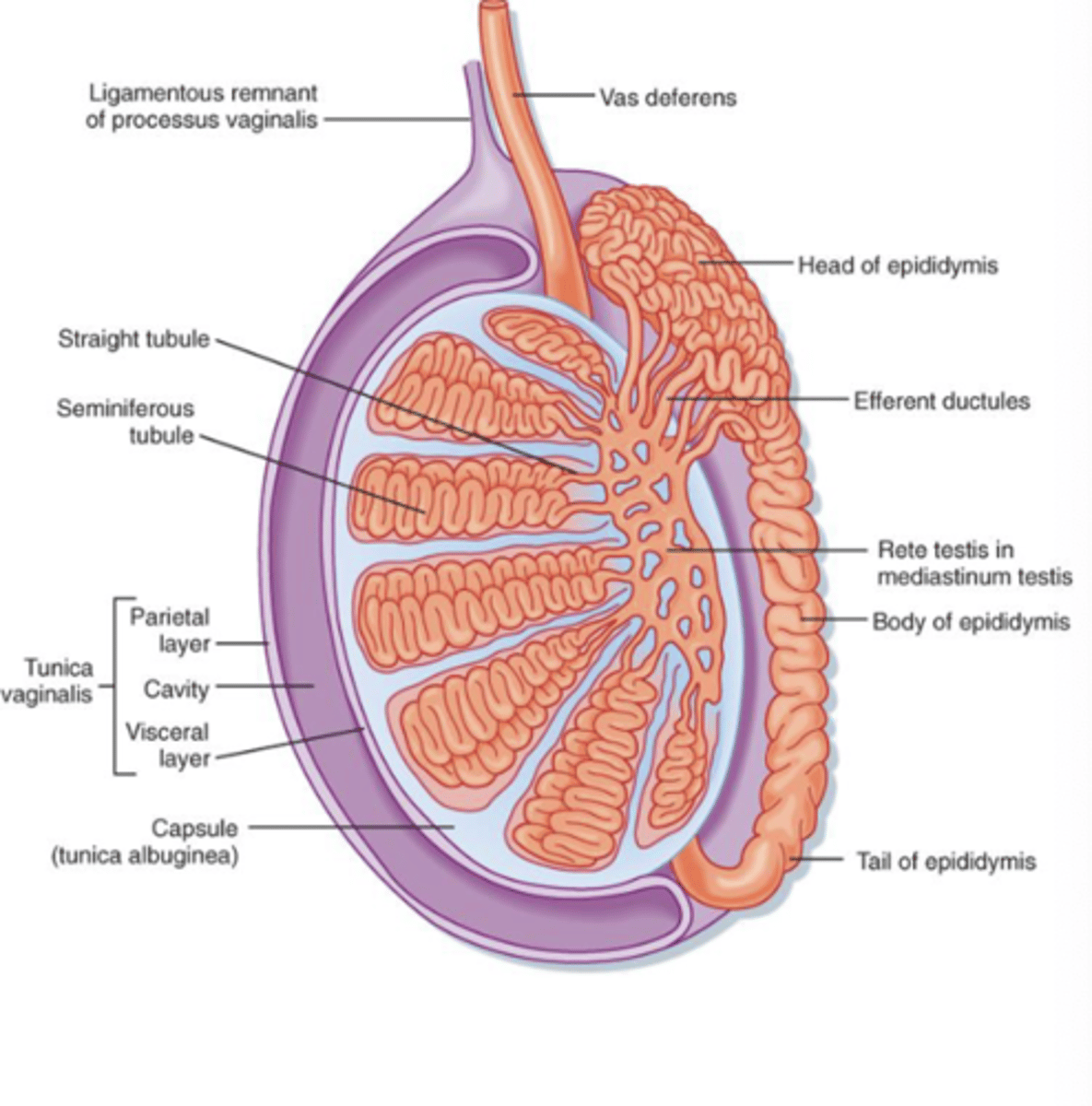
What are the testes largely composed of?
seminiferous tubules==> spermatozoa are formed w/in

what is the function of the rete testes?
act as sperm reservoir ==> once sperms is formed in the seminiferous tubules, they move to the rete teste
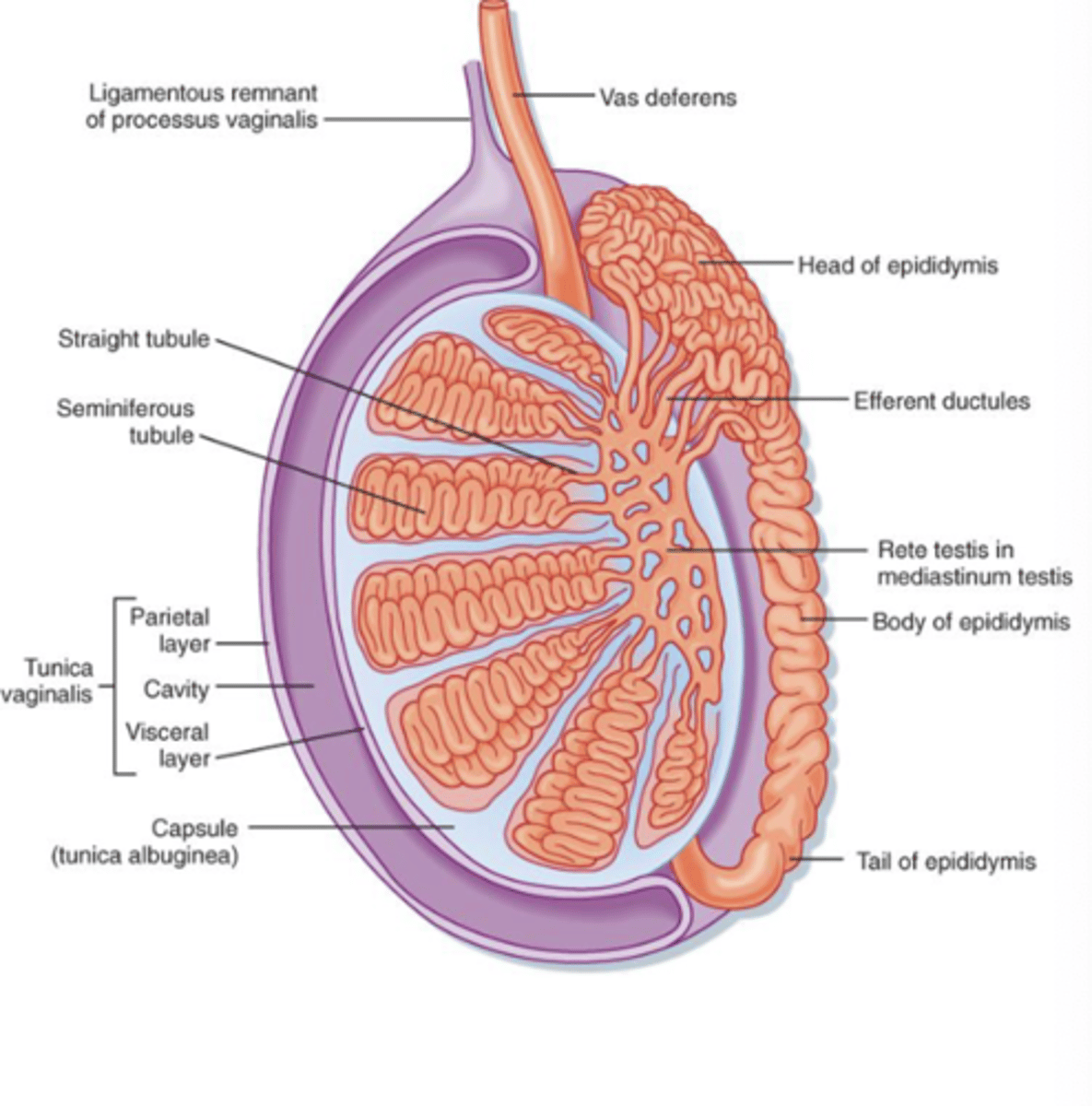
which ducts carry spermatozoa along with glandular secretions?
-epididymis
-Vas Deferens (ductus def)
-ejactulatory duct
-urethra
-penis
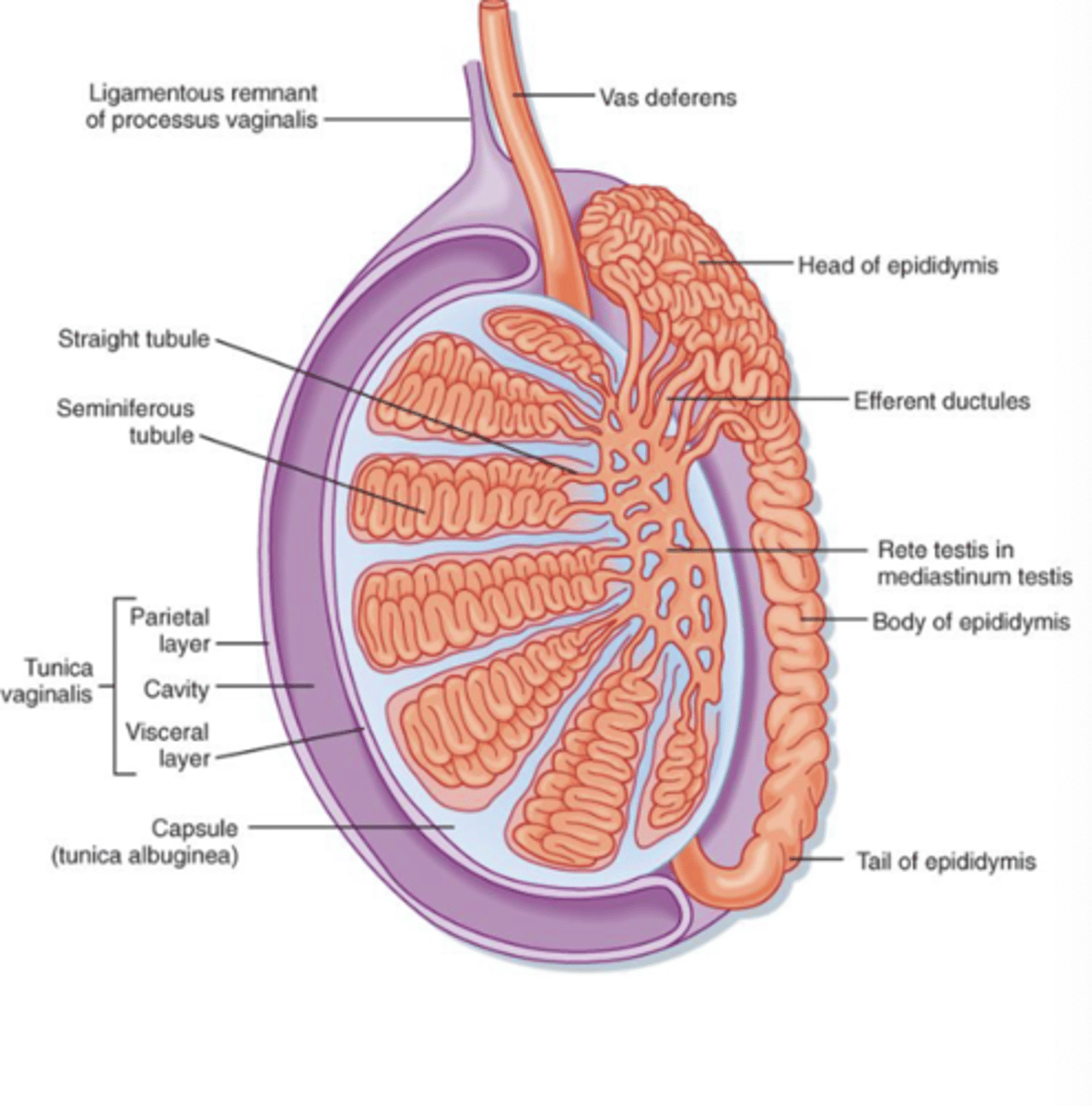
describe how sperm travels through the testes & penis
seminiferous tubules --> rete testes --> efferent ductules --> epididymis --> vas deferens --> ampulla--> ejaculatory duct -->prostatic urethra --> bulbous urethra-->penile urethra
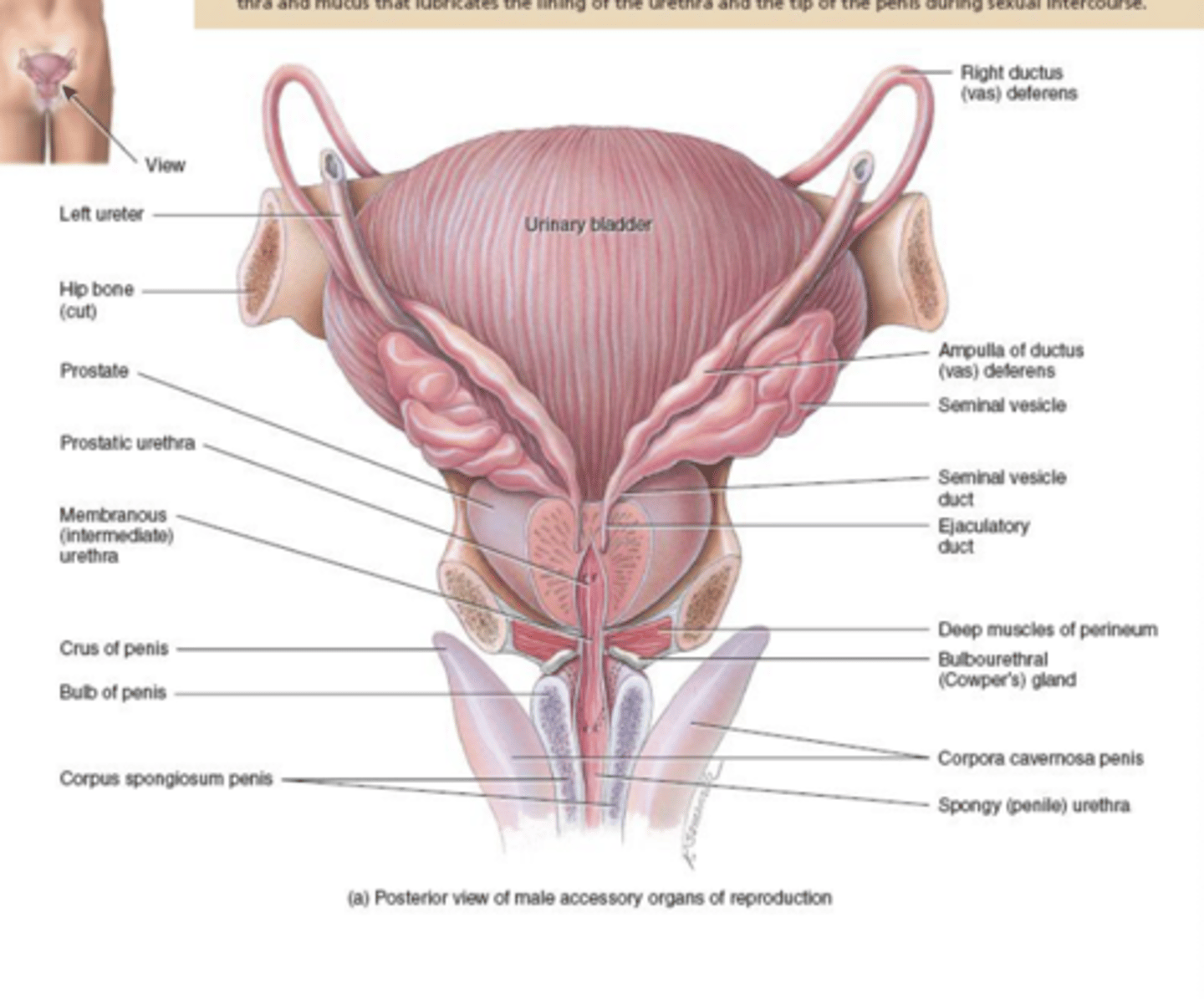
what are the most immature germ cells of the male reproductive system?
spermatogonia
Where are the most immature germs cells located within the seminiferous tubules?
spermatogonia are located near the periphery of the tubule ==> lie on the basement membrane of seminiferous tubules

Where are the mature germ cells located w/in the seminiferous tubules?
spermatozoa near the tubule lumen
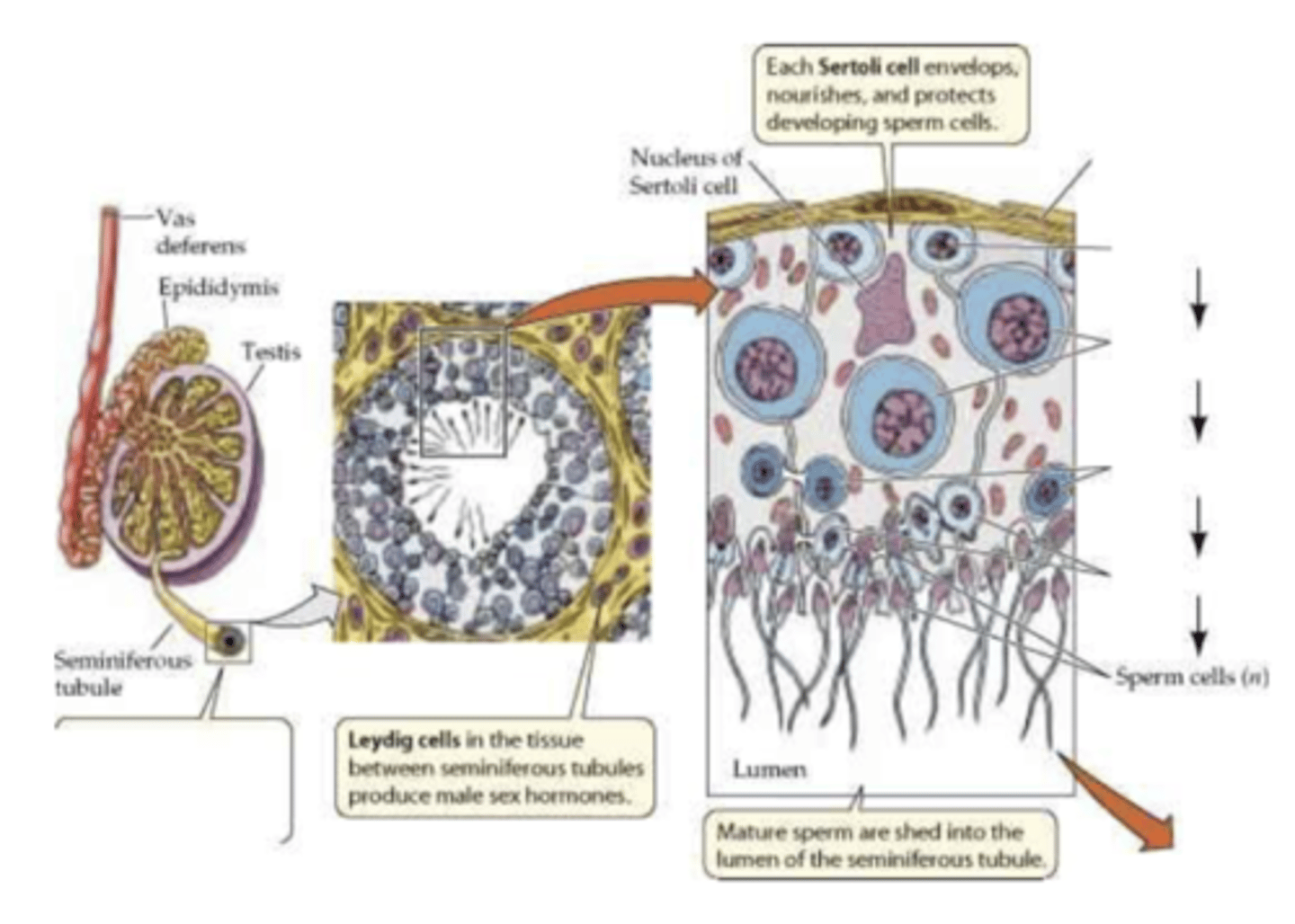
what are the mature germ cells of the male reproductive system?
spermatozoa
where are leydig cells located?
interstitial cells in the spaces bwtn the seminiferous tubules

what is the function of leydig cells?
produce male sex hormones
*interstitial cells located bwtn the seminiferous tubules
True or False: Spermatogonia are haploid
False ==> spermatogonia are diploid (2n) --> contain all the normal 2n # of chromosomes (22 autosomal + 1 X or Y)
describe spermatogenesis
spermatogonia undergo mitosis --> primary spermatocyte (2n) --> Meiosis I --> secondary spermatocyte (n) --> Meiosis II --> spermatids (n)
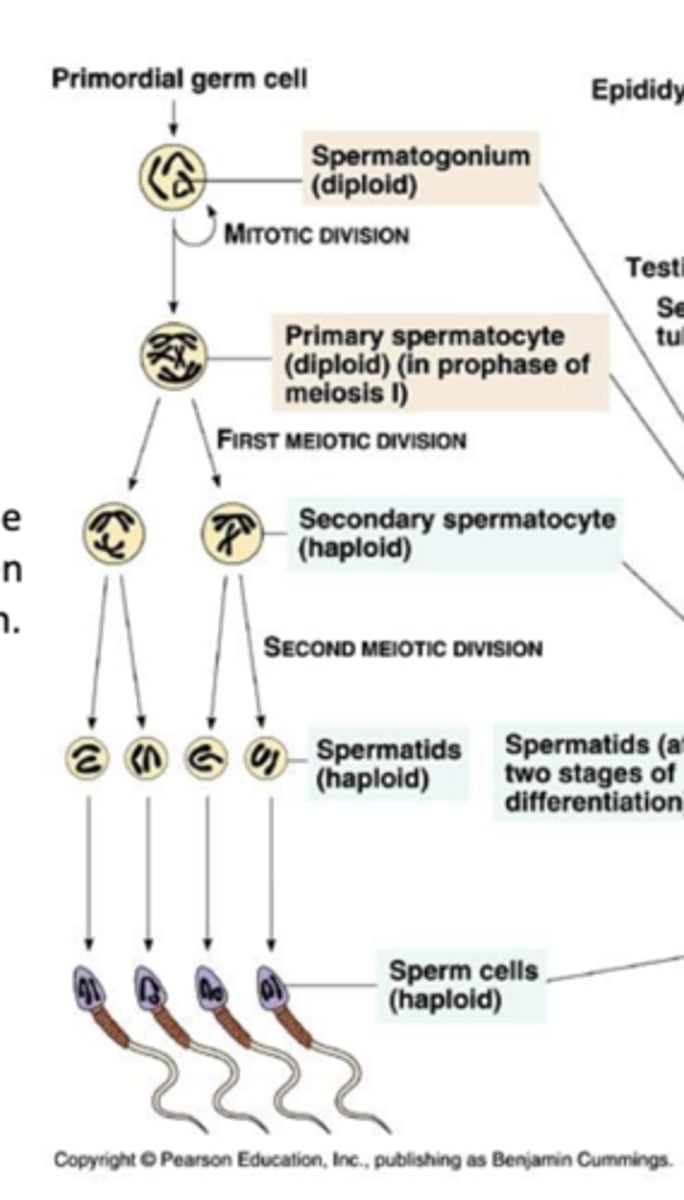
what is the final stage of spermatogeneis?
spermiogenesis ==> differentiation of spermatids into functional spermatozoa
what does spermiogenesis involve?
-formation of an acrosomal cap--> form the golgi apparatus covering the nucleus
-condensation & elogation of the nucleus
-formation of flagellum (tail) from centrioles
-formation of helical sheath of mitochondria in the midpiece
-removal of excess cytopalsm
what forms the acrosomal cap during spermiogenesis?
golgi apparatus covering the nucleus
what forms the flagellum during spermiogenesis?
centrioles
what forms the helical sheath in the midpiece during spermiogenesis?
mitochondria
what is the products of spermatogenesis?
each primary spermatocyte produces 4 spermatozoa
-2 w/ X chromosome
-2 w/ Y chromosome
True or False: As generations of spermatogonia mature, the more advanced cells are displaced toward the basement membrane
False ==> the more advanced cells are displaced towards the lumen of the tubule
How long does spermatogenesis take?
approx 74 days
Out of the 74 days of spermatogenesis, how many days does it take place w/in the seminiferous tubules?
50 days
Approximately how many sperm are produced in 1 day?
30 million in a 20 yr old
*declines with age, but males continue to make sperm everyday for life
True or False: Spermatogenesis occurs throughout adult life in the male
True
What is the function of follicule-stimulating hormone (FSH) in males?
binds receptors on Sertoli cells --> synthesis of androgen-binding protein (ABP) + P-450 aromatase + growth factors + inhibins
*necessary for sperm formation & leydig cell fxn
what is the function of lutenizing hormone (LH) in males?
binds leydig cells to stimulate testosterone production
Lutenizing hormone in males is also known as ___________________.
interstitial cell stimulating hormone
Describe the feedback control of spermatogenesis
-testosterone inhibits GnRH from the hypothalamus
-testosterone inhibits LH from the anterior pituitary
-inhibin (produced by Sertoli cells) --> inhibits FSH
what extends from the basal lamina to the lumen of the seminiferous tubule & surrounds the germ cells in early stages of spermatogenesis?
sertoli cells
what is the function of androgen-binding protein (ABP)?
binds to testosterone to maintain high luminal concentration
*secreted into lumen via Sertoli cells (stimulated by FSH)
what is the function of p-450 aromatase?
converts testosterone to estradiol
*testosterone is made by Leydig cells & diffuses into Sertoli cells
what is the function of inhibins?
-act on leydig cells as growth factor
-inhibits FSH release
What is the function of sertoli cells?
-maintain high luminal conc of testosterone via ABP
-convert testosterone to estradiol via P450 aromatase
-secrete growth factors
-synthesize inhibins --> leydig cell growth factors + inhibit FSH
-physical & nutritional support of germ cells
-phagocytosis of excess cytoplasm shed during spermiogenesis & defective sperm
-secretion of fructose-rich medium into lumen
-established blood-testis barrier
what makes up the blood-testis barrier?
sertoli cells
what is the function of the blood-testis barrier?
-prevents entry of harmful substances from blood affecting the sperm
-prevents sperm-related proteins to enter circulation & provoke immune response
what stimulates the production of testosterone by the leydig cells?
LH
How does Leydig cells communicate with Sertoli cells?
chemical crosstalk
-testosterone from leydig --> acts on sertoli cells
-sertoli cells produce estrogen--> regulates leydig cell function
what do the primary sexual characteristics in males depend on?
increased androgens at puberty
what are the primary sexual characteristics in males?
-growth of male genitalia--> penis, scrotum, prostate, seminal vesicles, & testes
-acquisition of the ability to produce sperm
what are the secondary sex characteristics in males?
-deepened voice
-hair distribution
-anabolic effects on skeletal muscle growth
-thickening of bones
-increased RBC production
-increased libido
what propels sperm through the rete testes & efferent ductules?
cilia
what propels sperm through the efferent ductules into the epididymis?
smooth muscle contractions
how long is the epididymis?
4 - 5 meters
how long does it take for sperm to travel through the epididymis?
12 -26 days
When does sperm gain forward motility?
during travel in the epididymis
*also undergoes changes in metabolism & shape
How does the vas deferens extend?
extends from the epididymis --> encircles the urinary bladder --> expands into an ampulla
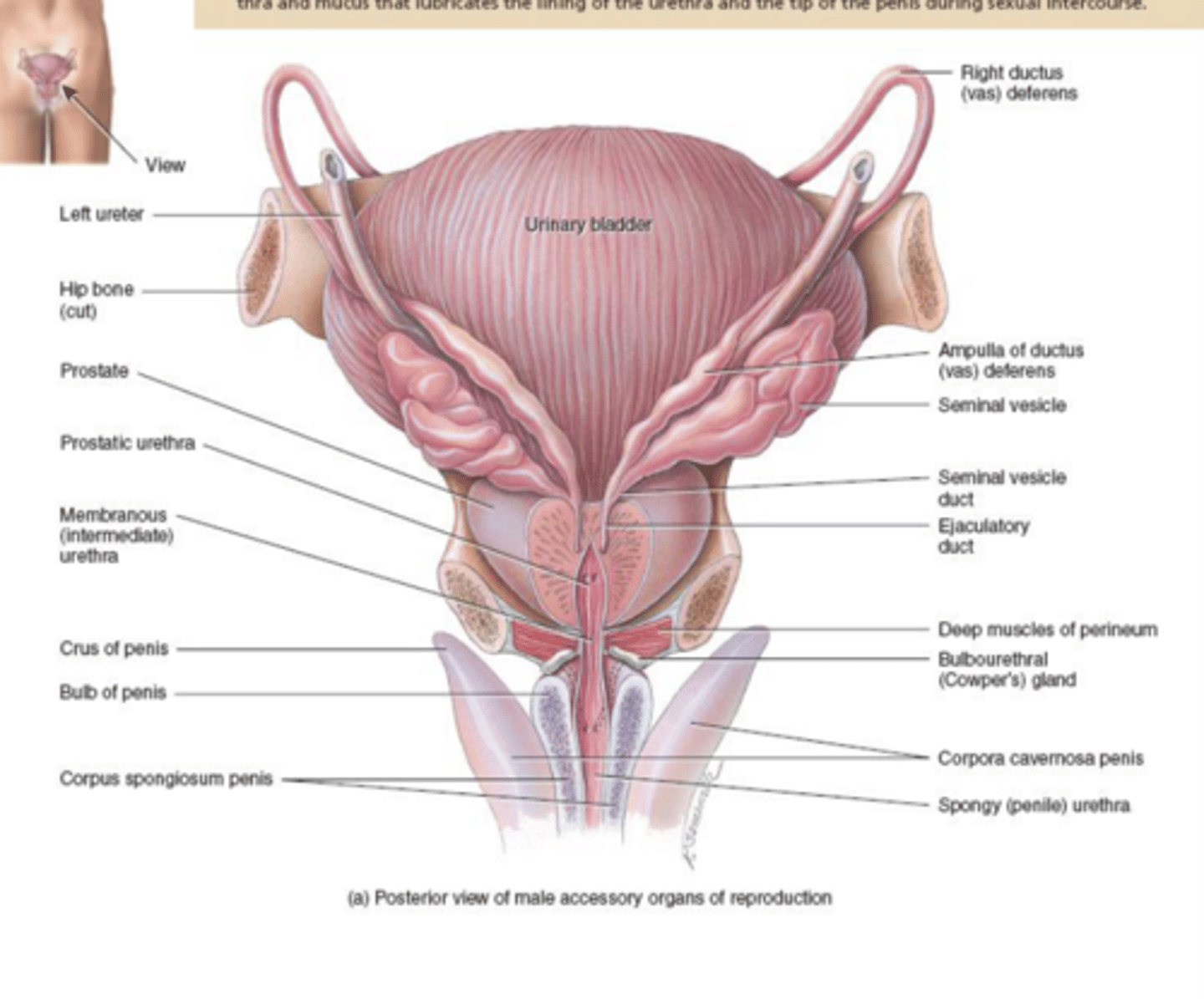
when does sperm receive fluids from the seminal vesicles?
after it exits the ampulla & enters the ejaculatory ducts
when does sperm receive prostatic secretions?
after it exits the ejaculatory ducts & enters the prostatic urethra
when does sperm receive input from the bulbo-urethral glands?
after it exits the prostatic urethra & enters the bulbous urethra
what glands do sperm receive input from as it travels to the penile urethra?
-seminal vesicles
-prostate
-bulbo-urethral glands

what is the function of the fluid secretion from the seminal vesicles?
-alkaline --> helps neutralize acid in the female reproductive tract
-provides fructose for ATP production by sperm
-contributes to sperm motility & viability
-helps semen coagulate after ejaculation
what is the function of the prostate secretion?
milky, slightly acidic fluid that helps semen coagulate after ejaculation & then helps break down the clot
what is the function of the bulbourethral secretion?
-alkaline fluid --> neutralizes the acidic environment of the urethra
-mucus --> lubricates the lining of the urethra & tip of penis during sexual intercourse
how much semen does a typical ejaculate contain?
2 -6 mL
sperm & fluid from the epididysis & vas deferens makes up what percent of semen?
approx 10%
What makes up 90% of the volume of semen?
accessory glands (seminal vesicles, prostate, & bulbourtheral glands)
Which accessory gland contributes the most to the volume of semen?
seminal vesicles (70%)
how much does the prostate contribute to the volume of semen?
19%
how much does the bulbourtheral glands contribute to the volume of semen?
1%
Bulbourethral glands are also known as ________________________.
cowper's glands
Sertoli cells are also known as ______________________.
sustentacular cells
True or False: Semen is isotonic to plasma
True
what is the pH of semen
7.4
which minor substances are found in semen?
-electrolytes--> Na+, K+, Ca2+, Mg2+, Zn2+, SO4, PO4, Cl-
-sugars
-Vitamin C, B, & E
-semenogelin
-acid phosphatase
-low MW proteins & peptides
True or False: The testes, epididymis, accessory glands, & erectile tissue are only innervated by the parasympathetic system
False ==> innervated by the SNS & PNS
True or False: In addition to autonomic innervation, the penis also has afferent & efferent connections to the somatic nervous system
True
What 3 processes does the male sex act involve?
-erection
-emission
-ejaculation
Describe the mechanism of action of an erection
PNS stimulation of vessels --> corpora cavernosa release ACh--> acts via G protein signaling --> increases nitric oxide synthase activity --> NO released & diffuses into vascular smooth muscles --> relaxes smooth muscle --> increases inflow of blood into the corpora--> increase penile size & rigidity
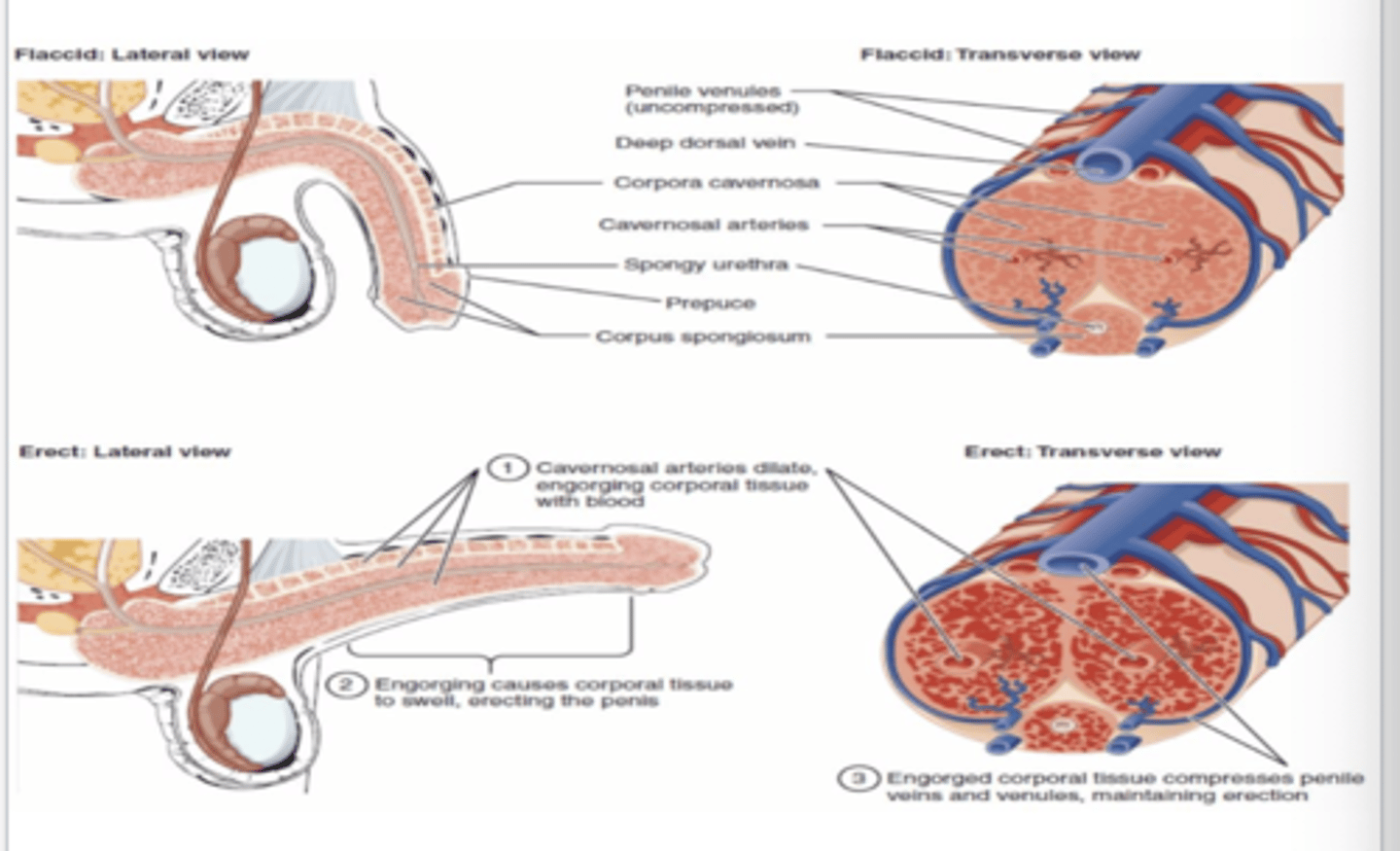
what is the function of the ishiocavernosa & bulbospongium?
skeletal muscles that surround the corpora in the penis ==> contract to further increase rigidity of the penis during an erection
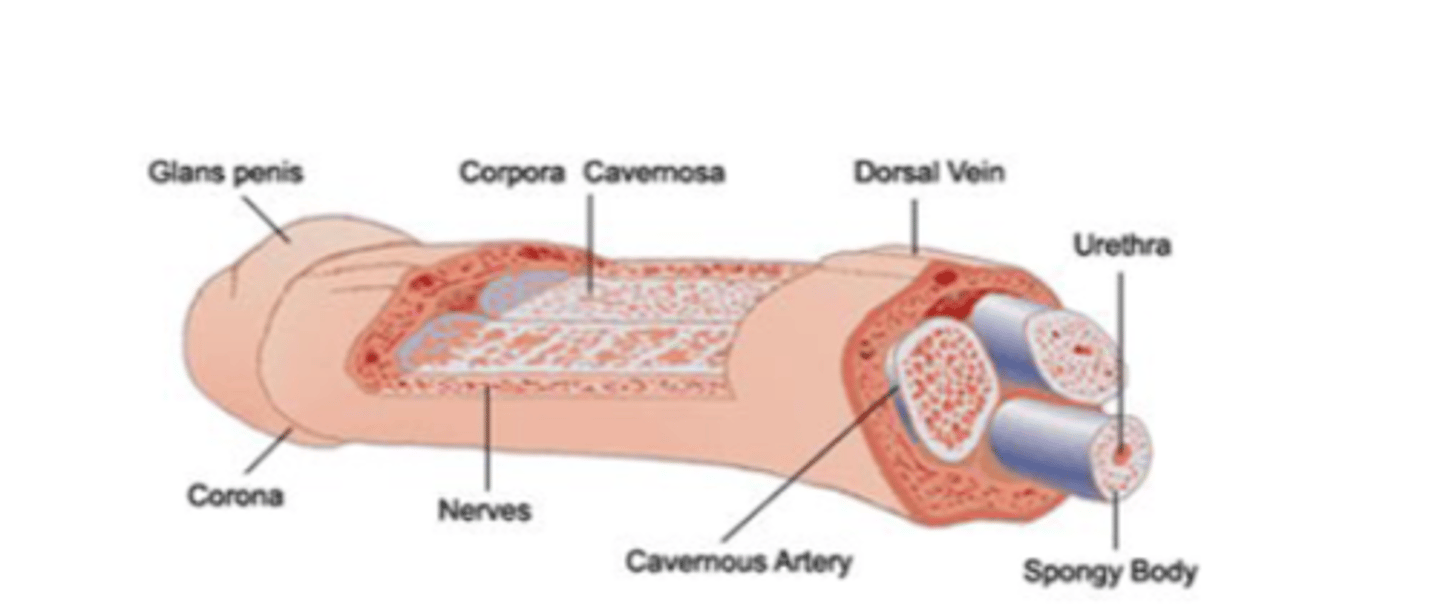
what is the consequence of the engorgement of the corpora during an erection?
compresses penile veins --> reduces outflow of blood

describe phase 1 of ejaculation
contractions in prostate, seminal vesicles, & vas deferens --> secretions forced into uretheral biulb --> closing of internal & external urtheral spinchters --> semen trapped in urtheral bulb
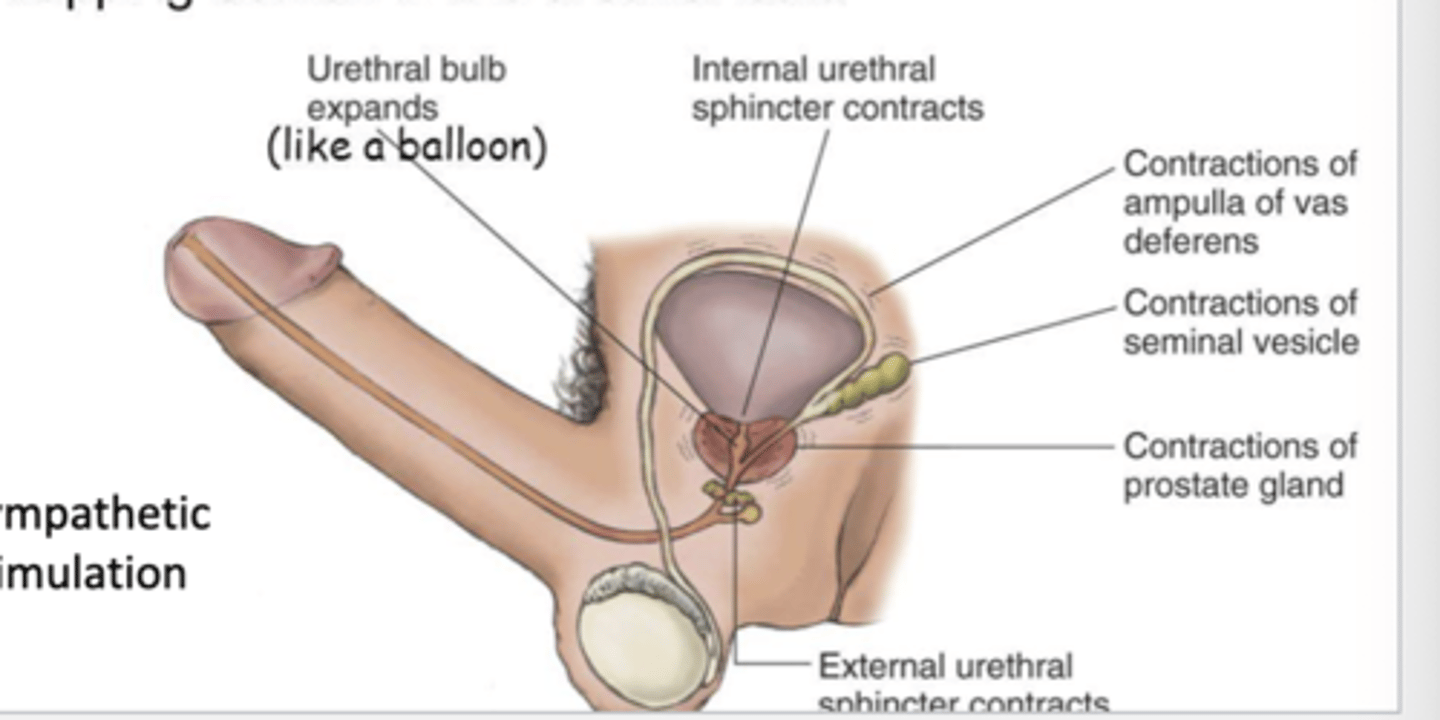
True or False: The emission phase of ejaculation is control by sympathetic stimulation
True
Describe the expulsion phase of ejaculation
movement of semen into bulbous urethra at the end of emission phase --> spinal cord reflex that causes strong rhythmic contractions of perineal, iso-cavernosus, & bulbospongiosus muscles (muscles surrounding the uretheral bulb & urthera) --> relaxation of external urethra sphincter --> allows semen out

which nerve is involved in the spinal cord reflex that causes strong rhythmic contractions of the perineal, ishio-cavernous, & bulbospongiosus muscles during he expulsion phase of ejaculation?
pudendal nerve
which muscles are stimulated by the pudendal nerve to contract during the explusion phase of ejaculation?
-perineal muscles
-ishio-cavernous muscle
-bulbospongiosus muscles
*surround the urethral bulb & urethra
If both semen and urine exit the penis via the urethra, how come urine does not exit with semen during ejaculation?
internal urethral sphincter (that connects to the bladder) remains contracted when the external urethral sphincter relaxes during ejaculation
what is the estimated sperm count in the ejaculate of a fertile male?
40 - 300 million/mL
what is a low sperm count?
less than 10 million sperm/ mL of ejaculate
What are some factors that can be measured in male ejaculate?
-liquefaction --> change from gel to liquid state (approx 15 - 20 min)
-morphology--> size & shape
-motility & velocity
-pH --> 7.2 - 7.8
what is the average volume of ejaculate?
2 - 6 mL